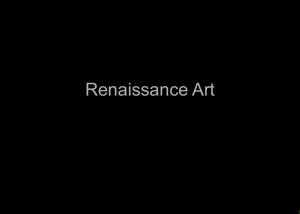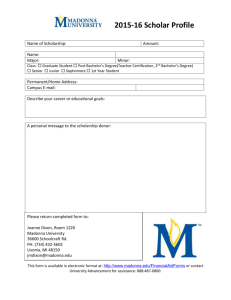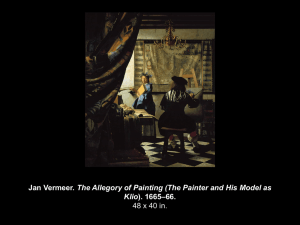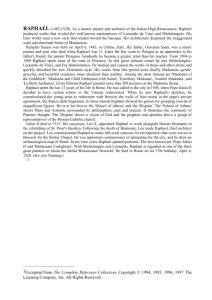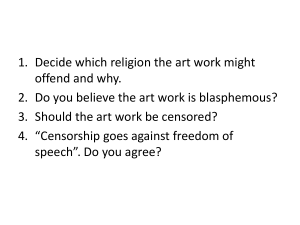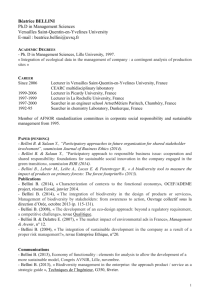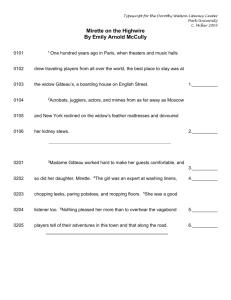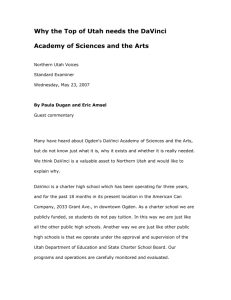Difference Between Medieval and Renaissance Art
advertisement
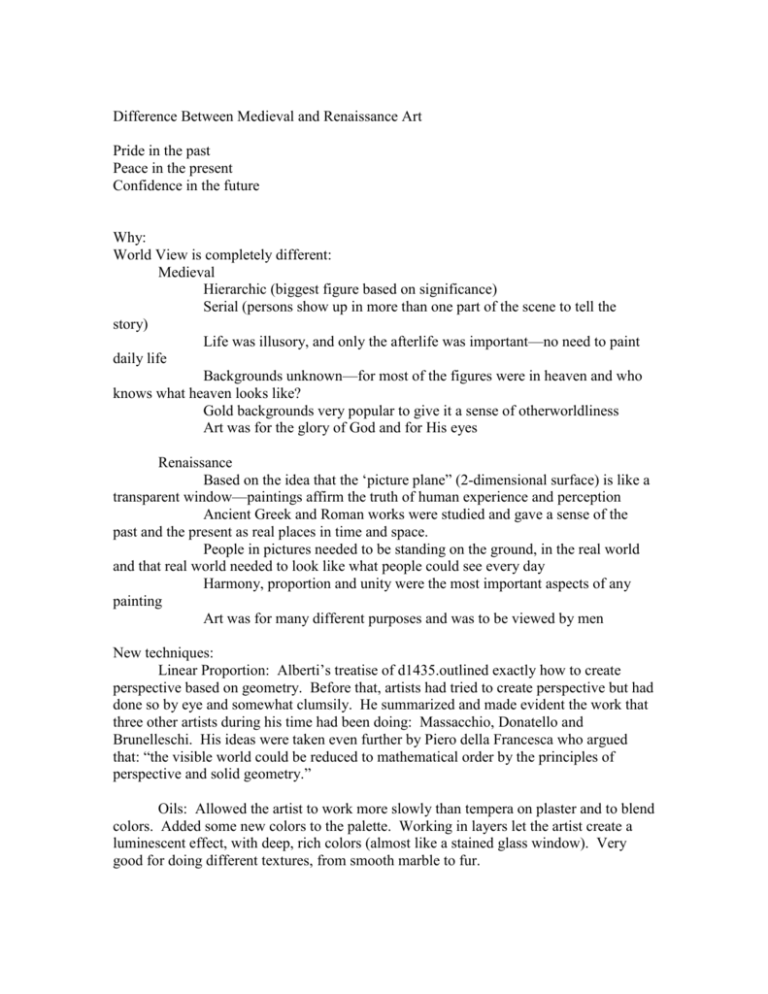
Difference Between Medieval and Renaissance Art Pride in the past Peace in the present Confidence in the future Why: World View is completely different: Medieval Hierarchic (biggest figure based on significance) Serial (persons show up in more than one part of the scene to tell the story) Life was illusory, and only the afterlife was important—no need to paint daily life Backgrounds unknown—for most of the figures were in heaven and who knows what heaven looks like? Gold backgrounds very popular to give it a sense of otherworldliness Art was for the glory of God and for His eyes Renaissance Based on the idea that the ‘picture plane” (2-dimensional surface) is like a transparent window—paintings affirm the truth of human experience and perception Ancient Greek and Roman works were studied and gave a sense of the past and the present as real places in time and space. People in pictures needed to be standing on the ground, in the real world and that real world needed to look like what people could see every day Harmony, proportion and unity were the most important aspects of any painting Art was for many different purposes and was to be viewed by men New techniques: Linear Proportion: Alberti’s treatise of d1435.outlined exactly how to create perspective based on geometry. Before that, artists had tried to create perspective but had done so by eye and somewhat clumsily. He summarized and made evident the work that three other artists during his time had been doing: Massacchio, Donatello and Brunelleschi. His ideas were taken even further by Piero della Francesca who argued that: “the visible world could be reduced to mathematical order by the principles of perspective and solid geometry.” Oils: Allowed the artist to work more slowly than tempera on plaster and to blend colors. Added some new colors to the palette. Working in layers let the artist create a luminescent effect, with deep, rich colors (almost like a stained glass window). Very good for doing different textures, from smooth marble to fur. Chiaroscuro: gradations of light and dark within a picture where forms are determined more by the meeting of lighter and darker areas than by sharp outlines. Contrapposto forms: Poses where the body is not straightly stiff, but twists either slightly (with weight on one side), or twists so that the head and shoulders face in a different direction from the hips. Gives movement to figures. Foreshortenting: painting perspective of body Focus on perspective: Early artists tried to do this but often got it wrong. Later artists used the vanishing point where parallel lines recede into the distance and come together at one point (like railroad tracks) Linear perspective also provides the idea that all objects grow smaller in all dimesions as they are further away from the picture plan. Artists often drew a “floor” and then a receding grid based on Alberti’s formula in order to determine the layout of the picture and how figures should look. Lippi, Couple at window, Raphael, school of Athens, Madonna and child, davinci drawing To provide perspective they did not use just Liner perspective: Overlapping Shapes: had been done in medieval times, but without the other types of perspective it wasn’t very helpful (Lippi, Adoration) (Fra Angelica, preaching) Aerial or Atmospheric Perspective: based on the realization that the atmosphere makes things in the distance look hazier and generally bluer. By making the far reaches of a landscape fuzzy, it made that area look further away from the viewer. (Giovanni bellini, infant bacchus) (davinci, carnation madonna) Light and Shadow: By using light and shadow to help create volume, artists could make a particular space have the look of depth.(bellini gentile, Jerome) (Francesca, dream) Focus on Human beings: Movement: (Michelangelo, study sybil) (da vinci, st. john) Proportions: (davinci, virtruvian man Foreshortening: (Mantagna, dead Christ) Focus on Compostion: Golden mean ( (Raphael, knight’s dream) (ghirliandros, last supper) Focus on Narrative: Story told often had symbols to help Objects in many Christian paintings are symbols connoting the perpetual presence and reality of the Passion of Christ. Thus, lilies in a jar could rep resent the Vi rgin Mary ’s purity, a fireplace could stand for sinful, lustful passions, and realistically represented light could be seen as Christ, the light of the world. Certain colors had symbolic meaning. Blue, the color of the sky, symbolized Heaven. Gold was a symbol of pure light, the heavenly element in wh i ch God lives. Red was a symbol of the blood of Christ or the Passion. Symbolism wa s p ro b a bly a pervasive worldview, rather than a practice relegated exclusively to art. Formats to tell a story Sequential (comic strip style): (mascacio, tribute money)(fabriano, adoration) continuous (main event part of everyday life) botticelli, adoration (Francesca, flagellation) fabriano, presentation) Single moment (crucial point) (Davinci, last supper) giotto , st francis death Types of paintings: Decorations for churches and civic buildings: huge works, often took years and even decades, fresco work, though some wooden panels (altarpieces) Portraits: after death, as gifts to commemorate an occaision At first ideal beauty, then later, more realistic, show characteristics Move from side (impersonal) to three-quarter (a little more personal) to full front (very direct) 1200s: begin to see a breaking away from convention and an emphasis on providing emotion in the paintings, to make it “speak” to people longing for religious meaning. A move to the more compassionate side of Christianity—why the Virgin and Child became so popular. This movement was helped along by the teachings of St. Francis, who focused on a simple life full of love and service. Pisano, N: two sculptures (Cimabue (madonab) 1300s: Interest in human beings and their surroundings began to become a strong force in art. Spurred on my humanistic ideas. In sculpture, new free-standing monumental sculptures are revived as an art form. Giotto: portrait of a young man, mandonna enthroned (little depth), marriage of the virgin (suitor with foot up), lamentation (emotion) Lorenzetti: good govt and bad govt (secular subjects) life of st Nicholas (some background) Pisano, Andrea: baptistery doors 1400s: Started with competition of 1401 in Florence to create doors to the Baptistery to rival those of Pisano. Ghilberti won and Brunelleschi became an architect. Still most work done in workshops by anonymous painters who were assts to a master. Most artists workshops did lots of thigns—gold smith, sculpture in stone and bronze, fresco painting, ect. Details about human beings and nature were being closely studied before being painted: anatomy, perspective, details of nature, landscape backgrounds and form and color in light. As more and more writings were deciphered from ancient Rome and Greece, a strong curiosity arose about the glorious past. Classic forms and subjects of art were considered appropriate. The classic ideal of beauty (beauty of the person reflects beauty of the soul) was reinstated. And harmony was the most important part of a piece of art— if something is taken away, then the whole is lessened. “Harmony” involved not just the component parts of the painting, but its relationship to the viewer. Ghiberti: doors, statues Donatello bust of niccolo (brought back classical sculpture) st rosser, david 1 and 2, gattmelata, Della Robbia: ascension, ma roses Brunelleschi: dome, a couple of other buildings Massacio: trinity (illusion of depth, viewer is at eye levl, pyramid composition, two donors at bottom), Madonna of humilty (tries foreshortening—doesn’t work well) Lippi, madonnas, annunciation, assumption Angelico: judas, szentek Mantegna, Madonna with angels, crucifixtion, infant savior, agony, rondele Gentile Bellini: st Jerome, sermon at st. mark, miracle Giovanni Bellini frari, san giobe, feast pieta,portrait of youth, Vittore Carpaccio (1460-1525), st Augustine, madman Botticelli, venus and graces, venus and mars, Madonna and child with angels, adoration of the magi, portrait of a youth Shops: Pollaiuolo family intense studies of human bodies—kept plasters of hands, feets, torsos, etc. on hand in shop. Ghirlandaios Andrea Verrocchio, medici, st Thomas, putti, boy on dolphin Shops wanted to make money without letting their art suffer, use trickes to help speed up process. 1500s: High Ren. Neo-platonism encouraged attempts to reconcile the pagan past with Christianity, and many pagan myths became allegories of Christian belief, with symbolism to mediate between the two. They still felt that the pagan past would not undermine the church, only illuminate Christianity for the better. The neo-platonist ideal of beauty reflected the idea that God was the source of beauty, that man was God’s image and therefore that the ideally beautiful man is the closest approximation of God on this earth. A stronger emphasis on place and time as part of picture. Illusion is played with. Use of canvas, which is much more portable that walls or wood panels. Have canvas will travel. Helped open up subject matter as didn’t have to paint huge pictures to make a living—could do lots of portraits—affordable. Leonardo virgin of rocks, st. anne, ermine, other portrait, last supper, mona lisa, drawings of lots of thigns. Raphael, school of Athens, small cowper, st. george, almuti, doni, alba, spozal, aragon Michelangelo, david, pieta, tomb, slave, moses, Sistine chapel, Contributions of the Renaissance for Art Naturalism (mantagna, gonzola family) (Francesca, saints2) Organization of Space (Raphael, Sistine Madonna), (bellini Giovanni, sangio altarpiece) Invention of parallel perspective (vanishing point) ( Classical motifs (mantagna, mars and venus) (botticelli, birth of venus) New Dignity of the Individual (Raphael, altovi) (botticellil, man with medal) Naturalism Organization of Space Invention of parallel perspective Classical motifs New Dignity of the Individual
